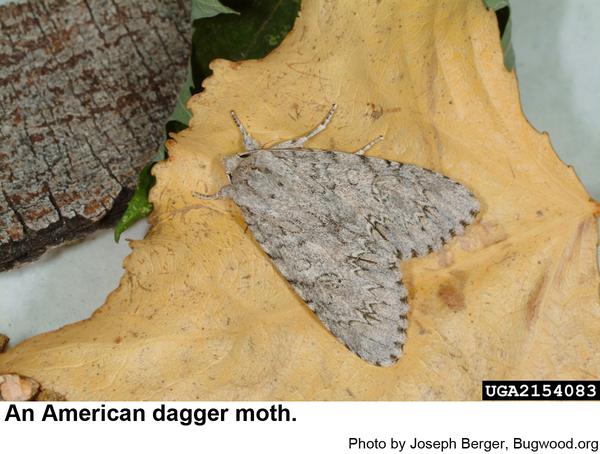Description and Biology
The American dagger moth, Acronicta americana, is so called because of markings on the forewing that resemble daggers (if you have a good imagination). These moths have grayish-white setae on the wings and upper legs. The wings are marked with faint black zigzags and a narrow, black ring about half way toward the head and slightly closer to the edge of each wing. A faint white band along the edge of the forewings is marked with black spots. It is most active from spring to early autumn. Dagger moth caterpillars are fuzzy with medium length yellow, yellowgreen, or even white setae. They also have four, elegant, slender, black "pencils" of setae that extend out from the first and third abdominal segments. A fifth pencil of black bristles extends near the rear of the caterpillar. It is reputed that these pencils may break off and become embed into skin. Toxins supposedly inside the hairs are reputed to cause a stinging sensation that may develop into a rash. Caterpillars may grow as long as 2 inches and are often found on the soil near their host trees from July through late October. We probably have two generations per year in North Carolina.
Host Plants
The dagger moth caterpillars feed on the leaves of alder, ash, elm, maple, oak, willow, and other hardwood trees in yards, parks, backyards, forests and woodlands throughout the growing season.
Residential Recommendations
Only in rare instances have dagger moths become really noticeable pests. Most are noticed one or two at a time. Should they cause noticeable defoliation, most of the insecticides labeled for landscape use in residential landscapes will give more than adequate control. Dagger moth caterpillars that have matured and are searching for a suitable place to spin cocoons may appear to be resistant to insecticides. Such individuals can be trampled under foot.
Other Resources
- Acronicta americana – American Dagger Moth. Anonymous. No Date. North American Insects & Spiders.
- American Dagger Moth. Staff Writer. 2020. InsectIdentification for the casual observer, Insectidendification.org.
- Extension Plant Pathology Publications and Factsheets
- Horticultural Science Publications
- North Carolina Agricultural Chemicals Manual
For assistance with a specific problem, contact your local N.C. Cooperative Extension Center.
This Factsheet has not been peer reviewed.
Publication date: March 13, 2020
Reviewed/Revised: Jan. 9, 2025
Recommendations for the use of agricultural chemicals are included in this publication as a convenience to the reader. The use of brand names and any mention or listing of commercial products or services in this publication does not imply endorsement by NC State University or N.C. A&T State University nor discrimination against similar products or services not mentioned. Individuals who use agricultural chemicals are responsible for ensuring that the intended use complies with current regulations and conforms to the product label. Be sure to obtain current information about usage regulations and examine a current product label before applying any chemical. For assistance, contact your local N.C. Cooperative Extension county center.
N.C. Cooperative Extension prohibits discrimination and harassment regardless of age, color, disability, family and marital status, gender identity, national origin, political beliefs, race, religion, sex (including pregnancy), sexual orientation and veteran status.


